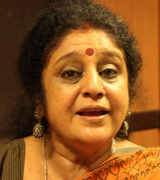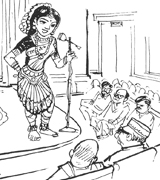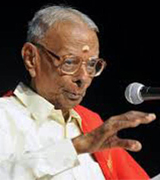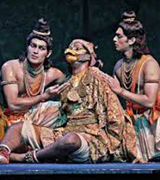COVER STORY
Beyond dance and dancer
CHITRA VISWESWARAN IN CONVERSATION WITH S. JANAKI

Bharatanatyam exponent and guru Chitra Visweswaran was conferred the Natya Kala Acharya award on 3 January 2014 in Chennai, at the inauguration of the annual dance festival of the Music Academy. In her acceptance speech, she requested patrons of dance to come forward to create a corpus to help indigent artists, and appealed to the Music Academy and corporate houses, through their social responsibility ventures, to also take up the issue. She expressed the hope that the government would also come forward to provide relief to a neglected segment of the fine arts. She later spoke to Sruti at length about young dancers and emerging trends in the dance season.
How was the Madras Season then, and how is the Chennai Season now?
I had my first experience of the Madras season in 1970 when I relocated from Kolkata to pursue my scholarship in Bharatanatyam. It was very exciting to see three or four festivals happening at the same time in the city. Look at the number now! (She laughs)
In Kolkata, where I spent a large part of my youth, I was exposed to the best of music and dance, Carnatic and Hindustani, presented by organisations like the Rasika Ranjana Sabha and Dover Lane. There were all-night performances at Dover Lane, but nothing happens like this Madras Season anywhere else in the world.
SEASON
Clones and Xerox copies
MUMBAIKAR

The month of Marghazi is synonymous with Chennai for a Mumbaikar like me who has been attending the season for the past 25 years or so. This year I was in for a pleasant surprise with autorickshawwallas charging me only by the meter. No haggling, as I went sabha hopping, no “Pottu kudungo saar” as soon as you hailed an auto. I went from one venue to another in a relaxed frame of mind to enjoy the classical dances.
Dance during this season was mostly about Bharatanatyam and the margam. Very much like today’s generation, most dancers seemed like clones or xerox copies. Many of them performed the same items. You even found the same accompanists for different dancers at different venues!
By the end of the season, sandalwood must have been ground to nothingness. Having watched umpteen nayikas preparing sandalpaste on stage for the beloved in numerous sessions – morning, post-lunch, evening and night – I can proudly claim to have gained expertise in the intricacies of making sandalpaste, from the choice of wood to the texture of the paste and the amusing variety in the grinding techniques on show. On a serious note, this overkill of the ashtapadi Kuru Yadunandana by dancer after dancer, enacted without conviction, was indeed sad.
TRIBUTE
“Appreciation from vidwans is the highest award”
R.K. SRIKANTAN IN CONVERSATION WITH AISHWARYA SRINIVAS

Vidwan R.K. Srikantan passed away in Bangalore on 17 February 2014. He was one of the oldest masters of classical music. He continued to perform like no other at a ripe age. He was a predominantly self-made artist in an art that requires training from a guru for a long period, and he has passed on the art to numerous disciples who have made a name for themselves. Just before his concert at the Music Academy, this nonagenarian was playing an imaginary tic-tac-toe on the ground with his walking stick, as he waited for his retinue to arrive. His biography titled Voice of a Generation, was released on his birthday on 14 January in Bangalore. It was indeed very inspiring for Aishwarya Srinivas to interview her guru Sangita Kalanidhi R.K. Srikantan, a Padma Bhushan awardee, and to learn about his long career as a musician, a few days before he turned 94.
Who inspired you when you were a young listener?
I attended the concerts of great masters like Ariyakudi Ramanuja Iyengar, Maharajapuram Viswanatha Iyer, Chembai Vaidyanatha Bhagavatar, Palghat Rama Bhagavatar, Veeruswami Pillai and tavil Meenakshisundaram Pillai at Bangalore and in Chennai where my brother lived. That gave me the inspiration to take up music as a career and earn the kind of vidwat and gauravam that these musicians made for themselves. I sat through these concerts with eyes closed and tried to reproduce all the nuances. I was eager to imbibe the good in all the styles and also weed out anything that was not required. I was also keen to take criticism in the right spirit.
INTERVIEW
Reviving Sabari Moksham
A. JANARDHANAN SPOKE TO ASHWINI VISWANATHAN

Sabari Moksham, a dance-drama in the Ramayana series, composed and directed by Rukmini Devi Arundale, was revived during the 2013 Kalakshetra Art Festival. Excerpts from an interview:
You staged Sabari Moksham recently. What have been the changes in it from the original production?
There are bound to be changes through the years. I know what Rukmini Devi Arundale had in mind when she choreographed Sabari Moksham. She always explained clearly what had to be incorporated in the dance-drama. She had a knack of choosing the right artist for each role and bringing out the best in him or her. As my colleagues like Dhananjayan and Balagopalan and I were trained in Kathakali, it helped us, as we knew the story and characters very deeply. Therefore the first show was outstanding and there can never be another show like that. In the recent version, any deviation has been in the way the characters are understood now, not in the presentation. The way in which each artist absorbs and understands a role he is taught is different.


